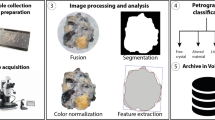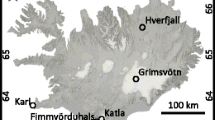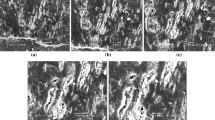Abstract
We develop a new method for characterizing the properties of volcanic ash at the Sakurajima volcano, Japan, based on automatic processing of CCD camera images. Volcanic ash is studied in terms of both luminance and particle shape. A monochromatic CCD camera coupled with a stereomicroscope is used to acquire digital images through three filters that pass red, green, or blue light. On single ash particles, we measure the apparent luminance, corresponding to 256 tones for each color (red, green, and blue) for each pixel occupied by ash particles in the image, and the average and standard deviation of the luminance. The outline of each ash particle is captured from a digital image taken under transmitted light through a polarizing plate. Also, we define a new quasi-fractal dimension (D qf ) to quantify the complexity of the ash particle outlines. We examine two ash samples, each including about 1000 particles, which were erupted from the Showa crater of the Sakurajima volcano, Japan, on February 09, 2009 and January 13, 2010. The apparent luminance of each ash particle shows a lognormal distribution. The average luminance of the ash particles erupted in 2009 is higher than that of those erupted in 2010, which is in good agreement with the results obtained from component analysis under a binocular microscope (i.e., the number fraction of dark juvenile particles is lower for the 2009 sample). The standard deviations of apparent luminance have two peaks in the histogram, and the quasi-fractal dimensions show different frequency distributions between the two samples. These features are not recognized in the results of conventional qualitative classification criteria or the sphericity of the particle outlines. Our method can characterize and distinguish ash samples, even for ash particles that have gradual property changes, and is complementary to component analysis. This method also enables the relatively fast and systematic analysis of ash samples that is required for petrologic monitoring of ongoing activity, such as at the Sakurajima volcano.









Similar content being viewed by others
References
Aramaki S, Kobayashi T (1986) Change of the whole-rock chemical composition of the recent ejecta of Minamidake, Sakurajima. Bull Volcanol Soc Jpn 31:146
Brandt S (1976) Statistical and computational methods in data analysis, 2nd edn. North-Holland Publishing Company, Amsterdam, p 434
Cashman KV, Hoblitt RP (2004) Magmatic precursors to the 18 May 1980 eruption of Mount St. Helens, USA. Geology 32(2):141–144
Cioni R, D’Oriano C, Bertagnini A (2008) Fingerprinting ash deposits of small scale eruptions by their physical and textural features. J Volcanol Geotherm Res 177(1):277–287
Dellino P, Liotino G (2002) The fractal and multifractal dimension of volcanic ash particles contour: a test study on the utility and volcanological relevance. J Volcanol Geotherm Res 113(1–2):1–18
Dellino P, Gudmundsson MT, Larsen G, Mele D, Stevenson JA, Thordarson T, Zimanowski B (2012) Ash from the Eyjafjallajokull eruption (Iceland): fragmentation processes and aerodynamic behavior. J Geophys Res 117: B00C04, doi: 10.1029/2011JB008726
D’Oriano C, Bertagnini A, Pompilio M (2011) Ash erupted during normal activity at Stromboli (Aeolian Islands, Italy) raises questions on how the feeding system works. Bull Volcanol 73(5):471–477
Fukuyama H (1978) Geology of Sakurajima volcano, southern Kyushu. J Geol Soc Jpn 84:309–316
Genareau K, Proussevitch AA, Durant AJ, Mulukutla G, Sahagian DL (2012) Sizing up the bubbles that produce very fine ash during explosive volcanic eruptions. Geophys Res Lett 39:L15306
Heiken G, Wohletz K (1985) Volcanic ash. University of California Press, Los Angeles, p 246
Iguchi M, Tameguri T, Ohta Y, Ueki S, Nakao S (2013) Characteristics of volcanic activity at Sakurajima volcano’s Showa crater during the period 2006 to 2011. Bull Volcanol Soc Jpn 58:115–135
Ishihara K (2000) Characteristics and the occurring field of vulcanian eruption. Chikyu Monthly 22:308–314
Kobayashi T, Miki D, Sasaki H, Iguchi M, Yamamoto T, Uto K (2013) Geological map of Sakurajima volcano, 2nd edn. Japan, Geological Survey of Japan.
Lautze NC, Taddeucci J, Andronico D, Cannata C, Tornetta L, Scarlato P, Houghton B, Lo Castro MD (2012) SEM-based methods for the analysis of basaltic ash from weak explosive activity at Etna in 2006 and the 2007 eruptive crisis at Stromboli. Phys Chem Earth 45–46:113–127
Mandelbrot BB (1982) The fractal geometry of nature. W. H. Freeman, New York
Maria A, Carey S (2007) Quantitative discrimination of magma fragmentation and pyroclastic transport processes using the fractal spectrum technique. J Volcanol Geotherm Res 161(3):234–246
Matsumoto A, Nakagawa M, Amma-Miyasaka M, Iguchi M (2013) Temporal variations of the petrological features of juvenile materials during 2006 to 2010 from Showa crater, Sakurajima Volcano, Kyushu, Japan. Bull Volcanol Soc Jpn 58:191–212
Miwa T, Toramaru A (2013) Conduit process in vulcanian eruptions at Sakurajima volcano, Japan: inference from comparison of volcanic ash with pressure wave and seismic data. Bull Volcanol 75(1):1–13
Miwa T, Toramaru A, Iguchi M (2009) Correlations of volcanic ash texture with explosion earthquakes from vulcanian eruptions at Sakurajima volcano, Japan. J Volcanol Geotherm Res 184(3–4):473–486
Miwa T, Geshi N, Shinohara H (2013) Temporal variation in volcanic ash texture during a vulcanian eruption at the Sakurajima volcano, Japan. J Volcanol Geotherm Res 260:80–89
Riley CM, Rose WI, Bluth GJS (2003) Quantitative shape measurements of distal volcanic ash. J Geophys Res 108. doi: 10.1029/2001JB000818
Russell DA, Hanson JD, Ott E (1980) Dimension of strange attractors. Phys Rev Lett 45(14):1175–1178
Shimano T, Nishimura T, Chiga N, Shibasaki Y, Iguchi M, Miki D, Yokoo A (2013) Development of automatic volcanic ash sampling apparatus at active volcanoes. Bull Volcanol 75(12):1–7
Suzuki Y, Nagai M, Maeno F, Yasuda A, Hokanishi N, Shimano T, Ichihara M, Kaneko T, Nakada S (2013) Precursory activity and evolution of the 2011 eruption of Shinmoe-dake in Kirishima volcano—insights from ash samples. Earth Planet Space 65:591–607
Taddeucci J, Pompilio M, Scarlato P (2002) Monitoring the explosive activity of the July–August 2001 eruption of Mt. Etna (Italy) by ash characterization. Geophys Res Lett 29(8). doi:10.1029/2001GL014372
Watanabe K, Danhara T, Watanabe K, Terai K, Yamashita T (1999) Juvenile volcanic glass erupted before the appearance of the 1991 lava dome, Unzen volcano, Kyushu, Japan. J Volcanol Geotherm Res 89(1–4):113–121
Wright HMN, Cashman KV, Mothes PA, Hall ML, Ruiz AG, Le Pennec JL (2012) Estimating rates of decompression from textures of erupted ash particles produced by 1999–2006 eruptions of Tungurahua volcano, Ecuador. Geology 40(7):619–622
Yamanoi Y, Takeuchi S, Okumura S, Nakashima S, Yokoyama T (2008) Color measurements of volcanic ash deposits from three different styles of summit activity at Sakurajima volcano, Japan: conduit processes recorded in color of volcanic ash. J Volcanol Geotherm Res 178(1):81–93
Acknowledgments
We thank two anonymous reviewers and Dr. J. Taddeucci for their constructive reviews. This study was partially supported by the Global COE program of Tohoku University (Global Education and Research Center for Earth and Planetary Dynamics) and by the Ministry of Education, Culture, Sports, Science and Technology (MEXT) of Japan, under its Observation and Research Program for Prediction of Earthquakes and Volcanic Eruptions. This study was conducted at Tohoku University, the Institute of Seismology and Volcanology, Kyushu University, and NIED.
Author information
Authors and Affiliations
Corresponding author
Additional information
Editorial responsibility: J. Taddeucci
Rights and permissions
About this article
Cite this article
Miwa, T., Shimano, T. & Nishimura, T. Characterization of the luminance and shape of ash particles at Sakurajima volcano, Japan, using CCD camera images. Bull Volcanol 77, 5 (2015). https://doi.org/10.1007/s00445-014-0886-7
Received:
Accepted:
Published:
DOI: https://doi.org/10.1007/s00445-014-0886-7




